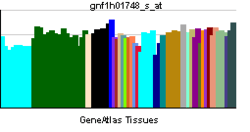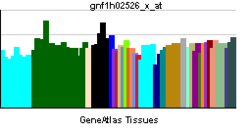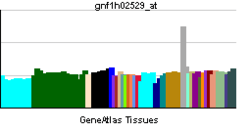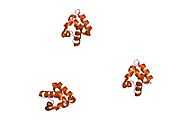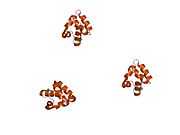SHANK3
SH3 and multiple ankyrin repeat domains 3 (Shank3), also known as proline-rich synapse-associated protein 2 (ProSAP2), is a protein that in humans is encoded by the SHANK3 gene on chromosome 22.[1] Additional isoforms have been described for this gene but they have not yet been experimentally verified.
Function
This gene is a member of the Shank gene family. Shank proteins are multidomain scaffold proteins of the postsynaptic density that connect neurotransmitter receptors, ion channels, and other membrane proteins to the actin cytoskeleton and G-protein-coupled signaling pathways. Shank proteins also play a role in synapse formation and dendritic spine maturation.[2]
Clinical significance
Mutations in this gene are associated with autism spectrum disorder. This gene is often missing in patients with 22q13.3 deletion syndrome,[3] although not in all cases.[4]
Interactions
SHANK3 has been shown to interact with ARHGEF7.[5]
Mouse models
Mouse models of Shank3 include N-terminal knock-outs[6][7] and a PDZ domain knock-out[8] all of which also show social interaction deficits and variable other phenotypes. Most of the these mice are homozygous knock-outs whereas all the human Shank3 mutations have been heterozygous.
References
- ↑ "Entrez Gene: SHANK3 SH3 and multiple ankyrin repeat domains 3".
- ↑ Boeckers TM, Bockmann J, Kreutz MR, Gundelfinger ED (2002). "ProSAP/Shank proteins - a family of higher order organizing molecules of the postsynaptic density with an emerging role in human neurological disease". J. Neurochem. 81 (5): 903–10. doi:10.1046/j.1471-4159.2002.00931.x. PMID 12065602.
- ↑ Sarasua SM, Dwivedi A, Boccuto L, Rollins JD, Chen CF, Rogers RC et al. (2011). "Association between deletion size and important phenotypes expands the genomic region of interest in Phelan-McDermid syndrome (22q13 deletion syndrome)". J. Med. Genet. 48 (11): 761–6. doi:10.1136/jmedgenet-2011-100225. PMID 21984749.
- ↑ Simenson K, Õiglane-Shlik E, Teek R, Kuuse K, Õunap K (2014). "A patient with the classic features of Phelan-McDermid syndrome and a high immunoglobulin E level caused by a cryptic interstitial 0.72-Mb deletion in the 22q13.2 region". Am. J. Med. Genet. A 164A (3): 806–9. doi:10.1002/ajmg.a.36358. PMID 24375995. Vancouver style error (help)
- ↑ Park E, Na M, Choi J, Kim S, Lee JR, Yoon J et al. (May 2003). "The Shank family of postsynaptic density proteins interacts with and promotes synaptic accumulation of the beta PIX guanine nucleotide exchange factor for Rac1 and Cdc42". J. Biol. Chem. 278 (21): 19220–9. doi:10.1074/jbc.M301052200. PMID 12626503.
- ↑ Wang X, McCoy PA, Rodriguiz RM, Pan Y, Je HS, Roberts AC et al. (August 2011). "Synaptic dysfunction and abnormal behaviors in mice lacking major isoforms of Shank3". Hum. Mol. Genet. 20 (15): 3093–108. doi:10.1093/hmg/ddr212. PMC 3131048. PMID 21558424.
- ↑ Bozdagi O, Sakurai T, Papapetrou D, Wang X, Dickstein DL, Takahashi N et al. (2010). "Haploinsufficiency of the autism-associated Shank3 gene leads to deficits in synaptic function, social interaction, and social communication". Mol Autism 1 (1): 15. doi:10.1186/2040-2392-1-15. PMC 3019144. PMID 21167025.
- ↑ Peça J, Feliciano C, Ting JT, Wang W, Wells MF, Venkatraman TN et al. (April 2011). "Shank3 mutant mice display autistic-like behaviours and striatal dysfunction". Nature 472 (7344): 437–42. doi:10.1038/nature09965. PMC 3090611. PMID 21423165. Vancouver style error (help)
Further reading
- Shcheglovitov A, Shcheglovitova O, Yazawa M, Portmann T, Shu R, Sebastiano V et al. (2013). "SHANK3 and IGF1 restore synaptic deficits in neurons from 22q13 deletion syndrome patients". Nature 503 (7475): 267–71. doi:10.1038/nature12618. PMID 24132240.
- Bangash MA, Park JM, Melnikova T, Wang D, Jeon SK, Lee D et al. (2011). "Enhanced polyubiquitination of Shank3 and NMDA receptor in a mouse model of autism". Cell 145 (5): 758–72. doi:10.1016/j.cell.2011.03.052. PMC 3110672. PMID 21565394.
- Tu JC, Xiao B, Naisbitt S, Yuan JP, Petralia RS, Brakeman P et al. (1999). "Coupling of mGluR/Homer and PSD-95 complexes by the Shank family of postsynaptic density proteins". Neuron 23 (3): 583–92. doi:10.1016/S0896-6273(00)80810-7. PMID 10433269.
- Sheng M, Kim E (2000). "The Shank family of scaffold proteins". J. Cell. Sci. 113 ( Pt 11) (11): 1851–6. PMID 10806096.
- Boeckers TM, Kreutz MR, Winter C, Zuschratter W, Smalla KH, Sanmarti-Vila L et al. (1999). "Proline-rich synapse-associated protein-1/cortactin binding protein 1 (ProSAP1/CortBP1) is a PDZ-domain protein highly enriched in the postsynaptic density". J. Neurosci. 19 (15): 6506–18. PMID 10414979.
- Hirosawa M, Nagase T, Murahashi Y, Kikuno R, Ohara O (2001). "Identification of novel transcribed sequences on human chromosome 22 by expressed sequence tag mapping". DNA Res. 8 (1): 1–9. doi:10.1093/dnares/8.1.1. PMID 11258795.
- Bonaglia MC, Giorda R, Borgatti R, Felisari G, Gagliardi C, Selicorni A et al. (2001). "Disruption of the ProSAP2 gene in a t(12;22)(q24.1;q13.3) is associated with the 22q13.3 deletion syndrome". Am. J. Hum. Genet. 69 (2): 261–8. doi:10.1086/321293. PMC 1235301. PMID 11431708.
- Soltau M, Richter D, Kreienkamp HJ (2002). "The insulin receptor substrate IRSp53 links postsynaptic shank1 to the small G-protein cdc42". Mol. Cell. Neurosci. 21 (4): 575–83. doi:10.1006/mcne.2002.1201. PMID 12504591.
- Bonaglia MC, Giorda R, Mani E, Aceti G, Anderlid BM, Baroncini A et al. (2006). "Identification of a recurrent breakpoint within the SHANK3 gene in the 22q13.3 deletion syndrome". J. Med. Genet. 43 (10): 822–8. doi:10.1136/jmg.2005.038604. PMC 2563164. PMID 16284256.
- Durand CM, Betancur C, Boeckers TM, Bockmann J, Chaste P, Fauchereau F et al. (2007). "Mutations in the gene encoding the synaptic scaffolding protein SHANK3 are associated with autism spectrum disorders". Nat. Genet. 39 (1): 25–7. doi:10.1038/ng1933. PMC 2082049. PMID 17173049.
- Moessner R, Marshall CR, Sutcliffe JS, Skaug J, Pinto D, Vincent J et al. (2007). "Contribution of SHANK3 mutations to autism spectrum disorder". Am. J. Hum. Genet. 81 (6): 1289–97. doi:10.1086/522590. PMC 2276348. PMID 17999366.
External links
| |||||||||||

